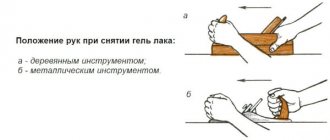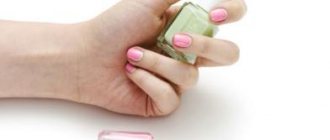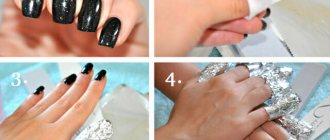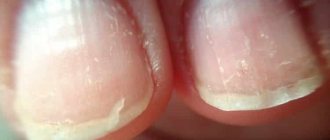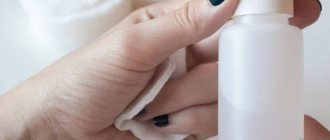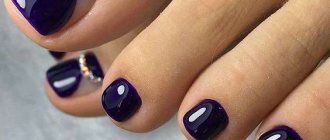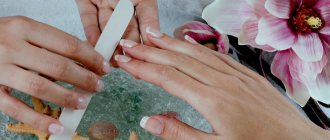If you have reached the stage of removing gel polish, you have probably already appreciated all its undeniable advantages: durability for 2-3 weeks, strengthening of the nail plate, a wide color palette, no long and painful wait for the coating to dry.
However, this material has one small drawback: the gel polish removal step takes longer than removing regular nail polish. And to carry out such a procedure, special liquids for removing gel polish are required.
You've probably heard that gel polish spoils your nails, making them thin and brittle. It is a myth! It's not the material that ruins your nails! One of the reasons for damage to the nail plate is improper removal of the artificial coating, so this procedure must be approached with special responsibility!
Is it possible to remove gel polish yourself at home without damaging your nails? What materials and tools are needed for this? Let's figure it out.
Removing gel polish or shellac coating
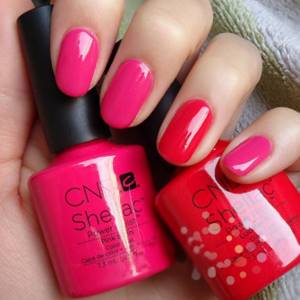
The basis of shellac (Shellac from Creative Nail Design, made in the USA) is a natural resin , thanks to which it is quite durable. Shellac or gel polish can stay on nails for 2 weeks or more. Article - how long does gel polish or shellac last? You need to understand that shellac is just one of the brands of gel polish manufacturers. As Pampers is one of the manufacturers of disposable diapers.
To remove this coating from nails in a salon, use a special product necessary to soften it - Product Remover , or carefully file off the coating with a milling cutter.
The master saturates the sponges with the liquid and places them on the nail plates, after which he wraps the fingertips in foil to secure them. After 10-15 minutes, remove the fingers one by one from the overlays and, using an orange stick, carefully pry off the coating - it easily comes off the nail surface. Otherwise the process is repeated. Irregularities in the nails are removed using a soft file or buff.
Professional products
Removers that are used in salons to remove shellac from nails are sold in almost any cosmetic store.
There are two main types of such funds:
- With acetone. A universal composition that allows you to remove any type of gel coating (gel polish, acrylic, biogel for extensions, etc.). A fairly aggressive product, but it helps to quickly clean the delicate surface. When using a solution with acetone, you must strictly follow the manufacturer's instructions for its use.
- No acetone. A safer composition that does not greatly damage the nail structure, but is only suitable for removing shellac. Due to its gentle effect, the liquid should be kept longer on the fingertips in the form of a compress.
Almost all liquids have a fairly low price - about 200 rubles per package, which is enough for 15-20 uses.
Methods for removing shellac or gel polish at home
In order to remove shellac from nails at home, you can use both professional liquid and other improvised means . This coating is usually removed using:
- regular nail polish remover;
- soaking nails in nail polish remover or isopropyl alcohol;
- files or buff.
It’s much easier for those who have a special tool. But what if you don’t have it at hand at the right time, and for some reason going to the salon is impossible?
Method number 1: Regular nail polish remover
The special product can be replaced with concentrated liquid for removing regular nail polish. Just pay attention: such a product must contain acetone . Other means will not work - they will not be able to soften the shellac even minimally.
| If there is no such liquid, then pure acetone or isopropyl alcohol will do. But the time that cotton pads soaked in these products remain on the nails is significantly reduced. |
For the removal procedure you need:
- Cotton pads or cotton wool.
- Regular foil, adhesive tape, tape - these will be needed to secure the cotton pads. Some people use polyethylene for these purposes, but it is not very convenient.
- Acetone nail polish remover, acetone or isopropyl alcohol.
- Orange sticks.
- File.
How to remove shellac with a manicure machine
You can also remove shellac with a hardware manicure machine. During this procedure, shellac is removed using cutters that rotate at high speed. Completely different cutters are used for regular manicure and nail polish removal. The high speed of the cutters ensures minimal heating of the nail plate, which allows you to keep it healthy.
Many people consider this procedure difficult and dangerous, arguing that you can overdo it and damage the plate. Here, first of all, everything depends on the skill and skill of the master. You should not try to carry out this procedure yourself, but rather contact a professional. The master will definitely fix your elbow so that there are no unnecessary movements and will remove the coating with gentle, stroking movements so as not to overheat the nail plate.

Question answer
- What is better to remove shellac: with a machine or liquid? Here the choice is entirely up to you. When removing with liquid, you should remember that our nail also absorbs liquid, and therefore deterioration of the condition of the nails cannot be avoided. The plates become dry and small inclusions appear on them. In general, of course, there is nothing wrong, but you shouldn’t resort to such a procedure all the time either. The device is a more professional and gentle approach, allowing you to remove the layer without damage. At first, this procedure seems daunting, but you shouldn’t put yourself in the hands of unfamiliar masters either. In the end, you can master science yourself by taking special courses.
- How to remove the sticky layer of shellac? If you don’t want to take risks and waste time on experiments, then you will still have to fork out the cash and purchase a professional cleaner. Why can't I use regular liquid? The risk of damaging the coating or ruining the color is still high. It is best to use a cleaner from the same company as the varnish, then they will interact perfectly with each other. And don’t forget that you need to remove the layer with lint-free synthetic wipes; ordinary cotton wool will not work.
- Is it possible to remove shellac from extended nails? Unfortunately, you can’t get everything at once. Many have unsuccessfully tried to carry out this procedure on extended nails, but this is only a waste of time (if you use an acetone-free product) and harms the extended nails. The usual scheme does not work here, the coating will not be removed, but the risk of damaging your nails is high.
- How long does it take to remove shellac? This depends on how you perform this procedure. On average, this procedure takes about 15 minutes or a little more if you do not use materials that create a greenhouse effect.
- How to remove shellac from the skin around the nail? There is no need to invent anything new in this matter, but you just need to use regular cotton wool or a cotton swab dipped in liquid. But do not rush to do this right away; it is better to wait until the coating has completely dried.
- Is it possible to remove shellac with a degreaser? Craftsmen are trying to go even further and try more aggressive means. But doing this is strictly not recommended. You can damage not only the plate, but also the skin of your hands.
As you can see, performing this procedure yourself is not difficult. We hope you found our simple and useful tips useful. Let your nails always be beautiful!
Advantages and disadvantages of home methods for removing shellac

The undoubted advantage of the first method is its low cost - you do not need to spend money on tools and materials, usually they can be found in every home. If you do have to spend money, they will be enough for several withdrawals. The advantages also include saving time - the procedure can be performed without waiting in line to make an appointment at the salon.
There are more disadvantages - some inconvenience is possible (when removing the coating on the right hand, the foil slips, when the nails of the first hand are wrapped in foil, it is difficult to prepare the other), an increase in the duration of the procedure up to an hour - when treating hands alternately, the risk of injury to the nail when using metal tools, or skin, exposure to a fairly aggressive liquid on the nails.
The advantage of soaking nails in nail polish remover or isopropyl alcohol is the speed of the procedure , the ability to observe the destruction of shellac and control the process. A significant disadvantage is the aggressive effect of the liquid on the skin and nail surface (drying), as well as possible injury to the nail surface when removing shellac with a metal pusher.
Cutting the shellac coating down to the base layer has its advantages - saving time, the ability to immediately apply a new coating. But with all this, you can touch or inadvertently cut off the entire top layer of the nail plate , thereby injuring and thinning it.
Removing shellac coating with a special liquid has more advantages than disadvantages. The first include the minimum time spent, the presence in such a product of components that can have a positive effect on the nail surface. The only disadvantages include possible inconvenience when removing the coating from nails yourself, and the risk of damage to the nail plate if you use the pusher carelessly.
Preparing hands and nails for shellac removal
Before removing shellac, your hands should be thoroughly cleaned. If sebum remains on them, it will reduce the effectiveness of the solvent. Wash hands and nails thoroughly with warm water and soap. After this, the nails are treated with a disinfectant solution.
For self-removal you will need some tools and materials:
- remover – acetone-based solvent;
- foil – food grade or used in beauty salons;
- essential oil for treating cuticles or rich hand cream;
- manicure file;
- cutters for cutting;
- glass and orange wood sticks;
- manicure brushes;
- cotton pads or sponges.
Before the procedure, it is advisable to conduct a sensitivity test to the soaking liquid.
Benefits of removing shellac in a salon
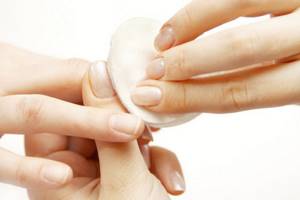
The most significant advantages of the procedure done in the salon are the shortening of the duration of the process due to the use of professional liquid, eliminating the risk of injury to the nail plates, complete removal of shellac without the remainder of a microscopic film. The specialist can also select suitable care products for the nails after removal.
Useful tips
- Be extremely careful with acetone-containing liquids. Avoid contact with skin and cuticles, mucous membranes and eyes.
- It is not recommended to use technical acetone to remove shellac. Its aggressive effects can dry out and damage the nail plate.
- Don't skimp on a quality shellac remover. It will allow you to carefully clean your nails and save time. A professional remover lasts from 5 to 8 minutes.
- Resist the temptation to speed up the process and cut off all the varnish or rip off the coating. This is extremely damaging to the nail.
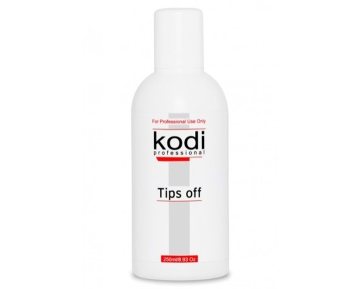
Professional remover
Differences between shellac and gel polish
Often the word “shellac” refers not only to the gel coating produced by CND , but also to other gel polishes. This definition is erroneous, since these products differ from each other in composition, consistency and properties.
Main differences:
- before applying shellac, the nails are treated with a degreasing agent; before applying gel polish, the nails are treated with a primer and the top layer is removed from the nail plate;
- Unlike gel polish, shellac does not contain harmful components such as formaldehyde and toluene;
- removing the shellac coating is quite simple - you just need to use a special liquid, but gel polish must first be filed down, and then use a liquid with an acetone base;
- shellac is more durable, but more expensive than gel polish.
| To remove shellac, it is best to use a remover from the same manufacturer. |
With all the convenience of shellac and gel polish coating, you should not forget to give your nails a rest. Therefore, you need to take breaks between coating applications ; they should be 10-14 days.
What is shellac
Initially, Shellak is a patented product of the CND brand. This is a combination of professional nail polish and gel. Manufacturers kept the composition of the product secret. We only know that it contains natural ingredients. Gradually, the word “shellac” became a household word. This is the name of the procedure using gel polish from different manufacturers.
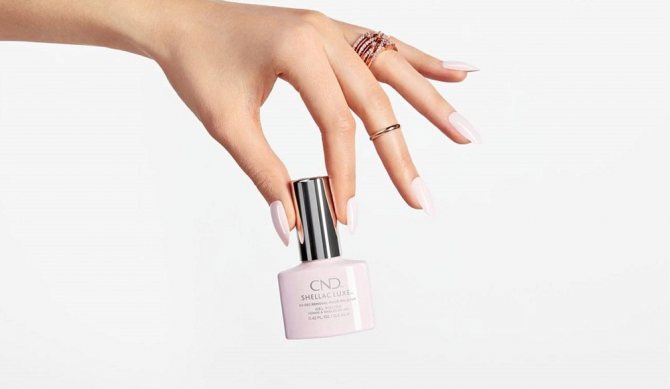
After applying the product, the nails are dried in an ultraviolet lamp. The coating allows you to create a bright manicure with a glossy shine. Lasts 2-3 weeks on nails.
To get a manicure or remove shellac, you usually go to a professional salon. However, if desired, the procedure can be performed at home.
Restoring nail plates after shellac removal

Often, after removing the shellac coating, it is discovered that the nail plates have weakened and become thinner. This means that a break is necessary, during which the nails are not treated with wellness treatments. During such periods, it is better to give the nail plates a rest and avoid applying even ordinary varnishes.
There are a huge number of simple bath recipes for strengthening thin nails . Some of them:
Add 1 tbsp to 100 ml of warm water. l. sea salt and 5-6 drops of iodine. You need to keep your nails in this bath for about 20 minutes, then dry them and apply a rich cream.
Bath with essential oils . You will need 250 ml of warm water, sea salt - 1 tbsp. l., grapefruit, tea tree and cedar oil - 1 drop each. Mix all the components, keep the nails in the resulting liquid for 10-15 minutes, then dry them and use a cream to moisturize or nourish the skin.
In order to strengthen the nail plates, you can use oils: almond, lemon, eucalyptus, chamomile, rosemary, sandalwood, apricot. To restore the structure of nails, you need to use oils: geranium, rosehip, tangerine, avocado. To get rid of yellowish nail plates, using lemon oil is effective .
| General healing properties of essential oils for nails: help accelerate their growth, soften the cuticle, give them a uniform color and shine. |
Thus, to safely remove shellac at home, it is necessary to follow the technology for removing this coating and not carry out manipulations that could damage the nail plate. Don’t forget about periodic restorative procedures for nails.
Mistakes when removing shellac yourself
Often, when trying to remove shellac or varnish on their own, girls make serious mistakes. As a result, they cause harm to their nails and skin. The most common technical errors include:
- complete cutting along with the base;
- attempts to remove shellac from nails with pure alcohol;
- holding the solvent for too long;
- removal from the tips to the roots of the nails;
- rough mechanical tearing off of the coating, including with a metal pusher.
Improper preparation and avoidance of cuticle oil can also have detrimental effects on your nails and finger skin. The plates will begin to delaminate and crumble, the handles will look unkempt.
When should you think about updating your manicure?
The guaranteed period of wearing shellac manicure is from 10 to 14 days. With proper care, this period can be significantly extended. But in any case, the day will come when you need to remove your nail polish in a beauty salon. Because even if the coating itself is not damaged and remains intact and smooth, the nails tend to grow back. And after a while, a strip of nail appears that is not covered with shellac, which negatively affects the aesthetic side of the manicure.
You may be interested in: Is it worth getting nail extensions: pros and cons, possible consequences, reviews

How not to remove gel polish
Some gel polishes begin to peel off near the cuticle after just a few days.
Usually the problem is either in the varnish itself, or in the fact that the nail technician did not degrease the nails enough before applying the coating. You want to tear off this shiny record, but you can’t do that. The gel penetrates into all the irregularities of the nail plate, so that by peeling it off, you can turn a small scratch into a full-fledged crack. A crack at the base of the nail is a very unpleasant thing. It's painful, very unsightly and simply unhealthy. And a healthy nail takes forever to grow.
Therefore, no matter how much you want, do not tear off the polish.
The exception is the gel that is not completely dried. You can easily peel it off and wash off the residue with acetone. How can you tell if the varnish is under-dried? It's simple: the nails smell unpleasant, they stick to everything, the polish smudges. You need to get rid of this as soon as possible, because the varnish can get into your food or stain your clothes.
You should also not wear the covering for too long. Due to heavily overgrown gel polish, the center of gravity shifts to the edge of the nail plate, so the nail can be broken.
Do we remove shellac with a pusher or a file?
Now we will reveal all the intricacies of this not entirely ordinary procedure. The information will be useful to many, given the craze for shellac.
Imagine scraping the top layer of epidermis from the skin of your face with a sharp knife or sandpaper. Terrible, isn't it? Your nails will feel the same as your skin if you decide to remove the durable shellac coating using a pusher or file. No matter how carefully you do this, you will still touch the body of the nail, or rather its top layer. It is clear that this will not add strength and health to him. It is impossible to cut off the shellac efficiently and completely at the same time without touching the plate.
As for using a pusher at home, after scraping you are guaranteed to peel off the nails and damage the integrity of the plate over the entire surface. The maximum that can be done is to carefully remove the already exfoliated parts of the coating, if there are any. And in terms of time it will be much longer than using more civilized methods, which will be discussed further.
What methods do specialized centers use?
In most cases, damage to the nail plate is caused not by the shellac itself, but by its “erasing” that does not comply with the rules. Professional solvents - removers or a special device with a cutter, which in some salons replace regular nail files, since the principle of the procedure is similar, helps to remove shellac correctly in the salon. The second method, despite its apparent danger, is more preferable from the point of view of preserving the integrity and health of the cuticle, nail plate and skin around it. Choosing the right way to remove shellac in a salon is not so easy. More on this later.

